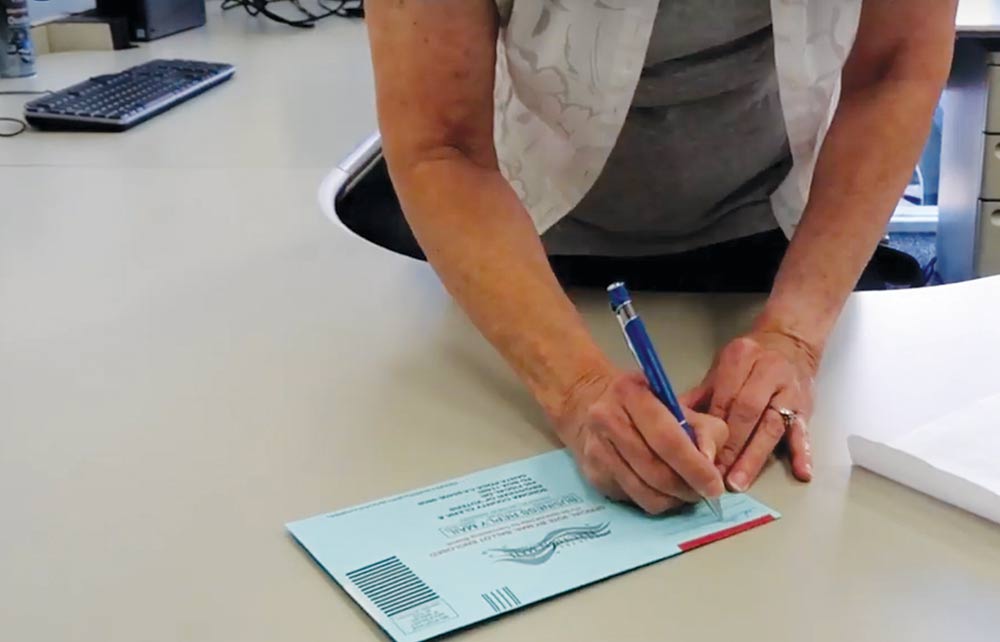With the Democratic primary fast approaching, some party members are concerned that a state rule will potentially prevent tens of thousands of independent absentee voters from participating in the party’s presidential primary this March.
Here’s the situation: if you are not registered with a political party—or you are registered with a handful of small ones—and you vote by mail, you need to request a new ballot or re-register in order to vote for one of the Democratic presidential candidates.
(If you vote in person but are registered as a no-party preference, then you can request a primary ballot at the polling place.)
In most elections, Californians vote for the top two candidates of any party, so registration doesn’t really matter. The same rule doesn’t hold in presidential campaigns.
In December, registrars in each county sent out postcards to impacted voters offering them a chance to change their registration. The numbers aren’t great.
The deadline to return the letters has passed, but voters can still register with a different political party or request a ballot with primary candidates directly from their county’s registrar.
However, given recent surges in the number of nonpartisan voters—and long-time increases in absentee voters—the policy could impact many voters who are not aware of the problem, according to polls.
“Voters that can’t overcome this procedural hurdle—and there may be as many as 600,000 of them, based on an analysis of 2016 data—won’t be able to vote for a presidential candidate. That’s enough votes to decide who will be the Democratic nominee,” Jessica Levinson, a Loyola Law School professor, and Paul Mitchell, a political commentator, wrote in a Jan. 2 Los Angeles Times opinion piece.
A GROWING CATEGORY
In California, where Democrats currently hold the vast majority of elected offices, there are more no-party preference voters than there are Republicans.
In Napa County, 26.12 percent of registered voters have no party preference. In Marin County, 24.56 percent are nonpartisan. In Sonoma County, 23.51 percent have no party preference, according to numbers from the California Secretary of State.
Pair that with the fact that vote-by-mail, also known as absentee voting, has grown in popularity steadily over the past 50 years.
In the 1966 primary, only 1.89 percent of California voters voted by mail. The rate increased significantly starting in the 1990s. In the 2016 primary, 58.92 percent of registered voters in California voted by mail.
A 2016 study by Capitol Weekly found that many people in the affected category intended to vote, but did not know about the problem.
“The study found that 88 percent of these [no party preference, vote-by-mail] voters are interested in voting in the upcoming [2016] election. Of those voters, two-thirds are interested in voting in the Democratic primary, while more than 17 percent are planning on re-registering to vote Republican,” Capitol Weekly reported at the time.
Between 2008 and 2016, the number of absentee, nonpartisan voters nearly tripled, from roughly 700,000 to 2,000,000, according to Capitol Weekly.
State law required each county to send a letter to every no-party preference, absentee voter in their county. In order to receive a ballot with the Democratic Primary candidates on them, voters had to fill out and return the letter; however, based on the return rates, it seems that many voters will be surprised they cannot vote in the primary election.
The Sonoma County Registrar of Voters sent out 47,965 letters. As of Friday, Jan. 17, they had received 9,234 back—a 19.25 percent rate of return.
The Napa County Registrar of Voters sent 21,253 letters. They have received 2,758 letters back—a 12.97 percent rate of return.
The Marin County Registrar of Voters sent out “about 30,000 postcards” and, at last count, had received about 5,000—or 16.7 percent—back, Lynda Roberts, the county’s registrar, said in an email on Friday, Jan. 17.
So far, the Marin County registrar has received roughly 1,500 email requests and an uncounted number of calls, according to Roberts.
The deadline to switch party registration is Tuesday, Feb. 18.
According to data from the Secretary of State’s Office, the number of registered Democrats increased from 7.4 million to 8.9 million, a bump in membership of 1.5 million. The number of nonpartisan voters increased from 4.1 million to 5.4 million—a 1.3 million increase. Meanwhile, the number of registered Republicans remained flat around 4.7 million.
Early Bird
That’s not the only significant change to the California primary this time around.
In 2017, then-Gov. Jerry Brown signed a law to move California’s primary to March 3, 2020. In election phraseology, March 3 is a Super Tuesday, when voters in over a dozen states will cast ballots.
Historically, voters in the Golden State would vote in June. But in 2016, the Democratic primary was pretty much done by June.
Recent polling shows that the top three candidates are fairly close together.
A poll from the Public Policy Institute of California (PPIC), released on Jan. 13, put U.S. Sen. Bernie Sanders ahead of the pack with 27 percent of likely voters. Former Vice President Joe Biden received 24 percent. U.S. Sen. Elizabeth Warren got 23 percent.
In 2016, the North Bay counties were split between Bernie Sanders and Hillary Clinton in the Democratic primaries.
Sonoma County, the most populous of the three counties, favored Sanders over Clinton 52 percent to 47.3 percent; Marin County voted for Clinton 56.4 percent to 43.3 percent; and Napa County chose Clinton in a 53.4 percent to 45.9 percent vote.








